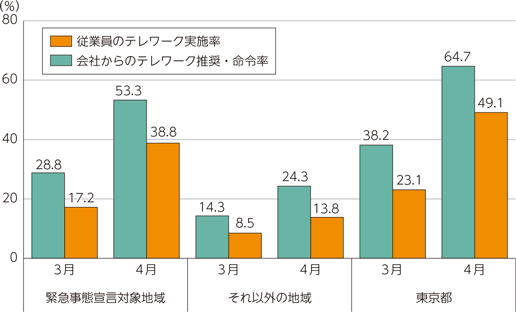How remote work started in Japan
How the state of emergency started
With the COVID-19 outbreak in Japan, a lot of people started working remotely in Japan. In Japan, the state of emergency was first announced in April 2020. With the announcement, many Japanese companies ordered their employees to work from home, unless their work needed to be executed offline. Before we look into how Japanese companies responded to the coronavirus, let’s see when and where the state of emergency was declared in Japan.

Timeline of the first state of emergency in Japan
Prime Minister Abe declared a state of emergency in the seven prefectures of Tokyo, Kanagawa, Saitama, Chiba, Osaka, Hyogo, and Fukuoka on April 7, 2020, and expanded the scope of the emergency to the entire country on April 16, 2020.
Then, on May 14, it was decided to lift the declaration of emergency in 39 prefectures, except for eight prefectures: Hokkaido, Tokyo, Saitama, Chiba, Kanagawa, Osaka, Kyoto, and Hyogo.
A week later, on May 21, it was decided to lift the declaration of a state of emergency for three prefectures, Osaka, Kyoto, and Hyogo. The declaration of a state of emergency continues in five prefectures: Tokyo, Kanagawa, Saitama, Chiba, and Hokkaido.
On May 25, the declaration of a state of emergency was lifted for the Tokyo metropolitan area, three prefectures, and Hokkaido. This is the first time in about a month and a half that the state of emergency has been lifted nationwide.
How Japanese companies responded to remote work
The graph below describes the percentage of employees working from home compared to March of 2020 and April of 2020. The blue chart indicates the % of people who got ordered or recommended by the company to work from home. The orange chart indicates the % of people who actually worked remotely. From the left section, it describes the area that was under the state of emergency, other areas, and the Tokyo metropolitan area.

According to this graph by the Ministry of Internal Affairs and Communications, you can see that Tokyo had the highest % company ordering its employees to work remotely and the % people who actually worked from home. Tokyo was one of the areas that were severely damaged by the coronavirus in Japan, so it makes sense that the % in Tokyo was particularly high.
When you compare March and April, it is clear that April 2020 had a higher rate of remote work for all areas. (Green chart and orange chart both increased compared to March) Therefore, we can say that this transitioning of office to online wasn’t something limited to Tokyo, but a phenomenon that spread throughout Japan.
Government push Japanese companies to work from home
The shortage of labor force in the future due to the declining birthrate and aging population, as well as the low level of labor productivity, which is the lowest among the seven industrialized countries, have long been pointed out as issues facing Japan. In other words, it was already widely known that Japan would eventually come to a standstill if things continued as they were.
There have been multiple efforts by the government to speed up the digital transformation of Japanese companies for a long time now. However, with the coronavirus spreading through Japan, governmental organizations and other entities such as Keidanren requested companies in Japan to start emphasizing a more online-based work style.
Under the emergency measures and priority measures to prevent the spread of the disease, these organizations requested companies to thoroughly implement various measures to prevent the spread of the disease, including telework, which aims to reduce the number of employees at work by 70%.
The truth of remote work in Japan
Current situation of remote work in Japan
In order to prevent the spread of coronavirus, a lot of companies have tested or implemented the work style of working from home or reducing the number of employees working in the office space. However, it cannot be said that all companies are complying with the requests made by the government and Keidanren. What is the current situation of remote work in Japan? We will look into the transition of how Japanese companies started implementing this work style after the spread of COVID-19.
The image below is a research done by Japan Productivity Center, which was looked into 1,100 people aged 20 or older employed by Japanese companies and organizations.

This shows that, in May 2020, 31.5% of people answered that they worked remotely. May 2020 was when Japan was faced with the first-ever state of emergency for the coronavirus. After July 2020, that percentage maintains around 20% till April 2021.
Next, have a look at the chart below. The first chart shows how the work productivity changed working from home, and the second chart shows how satisfaction changed working from home. You can see that in both charts, productivity and satisfaction are improving as time goes by. This indicates that a lot of people go more used to the work style, and perhaps companies put more effort into making a better online work environment.

Difficulties of working from home in Japan
Although, as the chart above indicates that workers are becoming accustomed to the new work style and that a lot of them are satisfied with working from home, there are difficulties and barriers to completely shift to an online work style. According to research done by a research team from NTT Service Evolution Laboratories and NTT Communication Science Laboratories, they found out that connections with colleagues with strong ties were maintained, but connections with colleagues with weaker ties were further weakened. A subject of the test commented as follows.
I feel like I communicate closely (with colleagues with whom I have strong connections). When I work remotely, I tend to have a lot of meetings with people I have frequent meetings with, but I only occasionally contact people with whom I have weaker connections.
Communication is an important factor, for deciding whether to shift complete online or remain some parts offline. It has a big impact on those, who are just joining the company, and they will easily get lost during the onboarding process, because of the difficulties to ask for help online.
In Japan, there are also workers who still need to go to the office, because some work is still based on paper. Fax machines are still used in major companies and some people tend to prefer paper instead of working online. Even, if the company you work for doesn’t use paper so much, maybe an important customer prefers using paper, thus forcing everyone associated to work offline. This is definitely another factor for people having to have to go to the office even under a state of emergency.

Will remote work stick in Japan?
Japanese people are moving out of big cities
In Japan, a lot of people are considering moving away from big cities to more rural areas. According to the Population Movement Report (including foreigners) for July released by the Ministry of Internal Affairs and Communications on July 26, the number of people moving out of the Tokyo metropolitan area (Saitama, Chiba, Tokyo, and Kanagawa) exceeded the number of people moving in by 1,829, indicating an outflow of the population for the first time in seven months since December 0f 2020.
Although it is hard to call this a trend, since the number of people leaving big cities is minimal and may just be temporary, it is a fact that some people actually did decide to move out from big cities, and that perhaps more people are considering moving out as well.
Is work from home here to stay in Japan?
Will remote work stick in Japan? With the coronavirus, Japanese companies started working remotely, but there are some obstacles that Japan needs to overcome in order to really make WFH stick in Japan. It is unclear when the pandemic is going to end, as long as the pandemic continues, it is likely that working from home will stay here a little longer. However, for Japan to overcome its long issue with low productivity and making improvements in working conditions, it might be a good time for Japan to really focus on remote work and trying to make a better environment for it.













